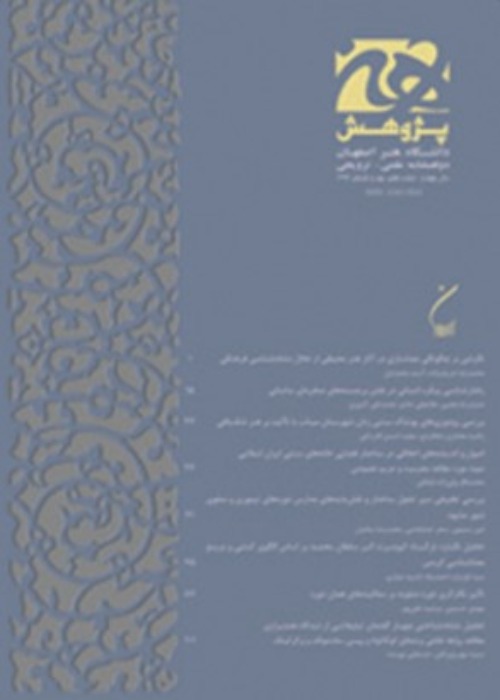Rereading the Front Inscription of Ghaffarieh Dome Based on a Historical-Comparative Approach
Author(s):
Abstract:
Ghaffarieh Dome, one of the most historically important monuments of Maraghe, was built by order of Ilkhan Abu Saied during Ilkhanid era. The dome enjoys several exquisite mosaic/enameled inscriptions. Only few parts of the front inscription have survived and the written content of the inscription could be found in nearly no sources; it is not clear for whom the dome has been constructed. On the façade of the dome, there is an inscription reading Sultan Abu Saied Ilkhan. Major parts of this inscription have been damaged. The content of this inscription has been read and recorded by André Godard in 1930's. While examining the inscription to restore it, several inconsistencies were found between Godard's reading and that of remained onto the plaster surface of the inscription in relief. Therefore, one of the major aims of the present study was to reread the content of the inscription once done by Godard. Available evidence indicated that different information could be obtained through rereading the inscription. The principle of preserving the originality of the work dictated that such information, however scantily, had to be recorded more exactly than before. This has to be done with utmost precision given the very old age of the monument and before the total disappearance of the inscription under study. To do, first different pictures were taken and different plans were provided. Then, they were compared with similar inscriptions. In this way, the justifiably reliable content emerged. The methodology was based on gathering data from field studies, library sources and on a comparative/inductive approach. The intended inscription, and many similar ones, is in real danger of vanishing. Therefore, reading the content and recording the vanishing evidence may help in preserving the originality of the inscriptions and associated historical and cultural values, from one hand, and in preventing bad interventions, from the other hand. One of the considerable achievements of this study was defining an approach to trace and to record the content of damaging mosaic inscriptions. In addition, the correct reading of the front inscription was provided and several new parts were identified as well. Also, the connotation of the newly found words was analyzed giving a relatively different interpretation of the content. All this indicated the importance of precise recording of historical inscriptions and that of application of systematic approaches to do so.
Keywords:
Language:
Persian
Published:
Journal of Pazhuhesh-e Honar, Volume:5 Issue: 10, 2016
Page:
25
magiran.com/p1515086
دانلود و مطالعه متن این مقاله با یکی از روشهای زیر امکان پذیر است:
اشتراک شخصی
با عضویت و پرداخت آنلاین حق اشتراک یکساله به مبلغ 1,390,000ريال میتوانید 70 عنوان مطلب دانلود کنید!
اشتراک سازمانی
به کتابخانه دانشگاه یا محل کار خود پیشنهاد کنید تا اشتراک سازمانی این پایگاه را برای دسترسی نامحدود همه کاربران به متن مطالب تهیه نمایند!
توجه!
- حق عضویت دریافتی صرف حمایت از نشریات عضو و نگهداری، تکمیل و توسعه مگیران میشود.
- پرداخت حق اشتراک و دانلود مقالات اجازه بازنشر آن در سایر رسانههای چاپی و دیجیتال را به کاربر نمیدهد.
دسترسی سراسری کاربران دانشگاه پیام نور!
اعضای هیئت علمی و دانشجویان دانشگاه پیام نور در سراسر کشور، در صورت ثبت نام با ایمیل دانشگاهی، تا پایان فروردین ماه 1403 به مقالات سایت دسترسی خواهند داشت!
In order to view content subscription is required
Personal subscription
Subscribe magiran.com for 70 € euros via PayPal and download 70 articles during a year.
Organization subscription
Please contact us to subscribe your university or library for unlimited access!


